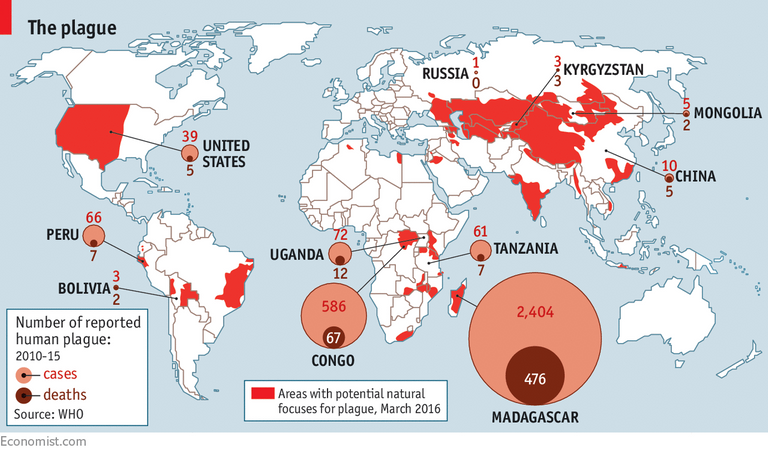Warning: Please Don't read if you're a hypochondriac.
I've been reading and thinking about The Plague lately (circa mid 1300's), I think partly because I recently had a minor staph infection on my scalp and my research into that led me to other bacteria, including the bacteria that was responsible for the Bubonic Plague (a.k.a the Black Death): Yersinia Pestis.
Rather than try to bore you, I want to share some choice interesting details about the plague that few people today even know about, which is fair considering the main event happened centuries ago.
First, the plague doesn't spread very often from person to person, which means the plague doctors in the 1300's who had the funny looking bird masks stuffed with flowers were not at much risk from their living patients. This particular bacterial infection mostly spreads from rodents via flea bites, but could also be spread from bodily fluids of a dead person or dead animal.
But that doesn't explain how so many people were infected and killed by the plague throughout Europe, and in other heavily populated areas around the Mediterranean Sea, the Middle East, and in Asia.
Some key factors that allowed the plague to spread so quickly:
- overcrowded cities
- bad hygiene
- no sewers or indoor plumbing, dirty water
- terrible poverty (by today's standards)
- rodent infestation
- lack of antibiotics
Basically, many European cities at the time were giant petri dishes for bacteria to spread.
Traditionally, the closer you get to the center of a city, the poorer and more dense the population becomes. In such an environment, rat or mouse infestations would be commonplace, along with moles and many other small animals. With these kind of infestations you get fleas, and not just on the family dog. We're talking the kind of fleas where everyone is walking around scratching all over and cursing about it.
Combined with bad hygiene, no plumbing, no sewers and no antibiotics, the poor stood no chance against the plague, and those who did survive infection inherited the wealth of any dead family members, if there was wealth to be had.
Another interesting tid-bit of knowledge is how silver is heralded as saving wealthy people from the plague.
I don't know how much truth there is in this, but this next part was told to me by an old WW2 veteran who had a million stories and would go on for hours about ancient remedies and weird historical factoids that I haven't heard elsewhere. He's likely long dead now, but I'll call him L for short. My favorite was L's story about Germans in WW2 mixing benzene and peroxide to power their "jet engines" on their airplanes, and how he watched a German air field while on recon, and how they would hose down and wash the planes during refueling like they had OCD, because a drop of either fuel coming into contact with the other would be extremely dangerous.
anyway, I digress. According to L, before penicillin was discovered, the antibiotic of choice was quicksilver. Silver, aside from its many other properties, is also antibacterial.
Like, extremely antibacterial.
It's safe for animals and plants in fairly large doses, but single-celled organisms apparently get robbed of oxygen in the presence of silver, or something like that, and it kills them fast. I'm going from memory here, and its been a couple decades since I chatted with L, so I may forget some details.
So, Quicksilver is also known as colloidal silver, which is silver particles suspended evenly in water via electrical charge, essentially, and is taken orally or put on wounds etc, and is also placed in the eyes of infants at birth to prevent eye infections. According to L, back in the 1300's they didn't have colloidal silver, but they had silver cutlery and silverware... at least the wealthy did. Silver jewelry that came into contact with the skin also helped apparently as it would be absorbed into the skin.
The only downside to ingesting silver is that something curious happens to people when they ingest too much over time; their skin turns a shade of blue. This is known as argyria (from the latin word for silver: argentum), and may also cause problems absorbing certain medicines for thyroid conditions, as well as interfering with antibiotics - probably because antibiotics are bacteria and silver is just as toxic for them as an infection.


Oddly enough, people who were born into wealth during the time of the plague were often said to be born with a silver spoon in their mouth, and the wealthy were often referred to as being blue-blooded. just a coincidence? Maybe, but not likely. Even though they didn't know about bacteria or other microscopic life back then, they did know that silver had some kind of magical healing properties for cuts and scrapes and other external and even internal ailments. And, because silver is the best thermal conductor in the world, someone with a fever will likely enjoy the cold feeling of silver on their skin as it pulls heat away.
Getting back to the original reason I wanted to write this blog, The Bubonic plague and how it could happen again.
It seems that in the past century, more and more people have moved from rural areas to bigger cities, and rarely the other way around. Being from a rural area myself, I am aware that it is often wealthy people from bigger cities that have camps/cottages in rural areas, and aside from the luxury of having a nature getaway, it's actually quite smart to have a rural getaway to escape a plague scenario, as unlikely as a plague outbreak would be.
That being said, this constant influx of people into cities is one of the key factors to increasing the risk of an outbreak. The more people that are packed together like sardines in tall skinny apartment buildings, the faster an outbreak of any kind will spread.
One thing that people today also don't know, is that the Bubonic plague still exists, and there are isolated cases around the world on a daily basis. This information is never publicly released or taught in public schools, because panicky people are unproductive people, and that's not good for any society.
Here's a world map with some plague numbers from 2016. Notice Madagascar's infection to death ratio... very sad to think that we've only contained the plague for centuries, but have never come close to wiping it out. This graphic only shows numbers from a few countries, so I imagine the numbers are much higher worldwide. But again, it's not publicly talked about, just like there are still cases of sars every year and family members of the affected are ordered to keep it quiet. Not speaking from personal experience, but I know someone who was told to keep silent while their loved one was dying in intensive care in front of them, and I can't imagine the anger and confusion they must have felt.

Luckily, if someone were to catch the plague (just casually, you know) we do have antibiotics today that decrease the chance of death from a staggering 30-90% all the way down to 10%. The 10% who still die after treatment are often physically compromised in some other way(s), which is not surprising given that the poorest and most impoverished people in over-crowded cities are the most at risk for all kinds of bacterial infections, let alone the Bubonic plague.
So far, despite the odd case here and there, people today are not at a huge risk of another outbreak of the plague. We have indoor plumbing, sewers, antibiotics, supplements, good hygiene (most of us), proper nutrition, and the most heroic of all: the common mouse trap. Millions of mouse traps are sold every year, and if you think it's funny for some people to be scared of mice, you can go pet and cuddle with them and their fleas all you like, but do it somewhere else please.
So what would change the situation so that the risk of plague were increased in modern times?
Keep in mind that as overcrowded as big cities were in the 1300's, our mega cities of today tower in comparison, and if rush hour and gridlocked traffic seem bad for a daily commute to work, try having everyone at once trying to flee, and running into quarantine barriers with militarized police shooting anyone who tries getting past them. Think I'm joking? That's one thing the zombie outbreak movies get right. Containment is critical in an outbreak situation, and morality goes out the window.
I can hear someone saying, "but we have all the things that keep us healthy, and keep rodents out of our homes, and keep bacteria from getting out of control, so where would a outbreak occur?"
That is the scary part of this blog post, because if you read my other stuff you know that the economy is cooking in a microwave somewhere, and we're likely heading into another great economic depression. With an economic depression comes increased poverty, homelessness and poor living conditions. This in turn leads to spotential increase in rodent infestation as houses, apartments and condos are left empty for months or years that people couldn't pay for.
If the economy (whats left of it) really tanks, and conditions get bad enough, then we can start seeing a breeding ground for mass infection, and unlike 1300's Europe, we are far better equipped to handle a plague, but at the same time with global shipping of goods and global tourism with planes and ships travelling everywhere, the chance of spreading a plague are much higher, especially because shipping port cities are often the biggest, like London, New York, Los Angeles etc, which means the best place for a plague to happen is also where the most commerce takes place.
So this is where I'm going to stop for this blog, and I hope you enjoyed reading this, or found it interesting. All of us carry around knowledge that we often think of as trivial, but it's become apparent to me that our perception of control in our modern times is borderline delusional. All it takes is a few years of dire poverty, and a large city that acts as a trade hub could become ground zero for the next world plague. Nevermind war, a plague would be worse I think.
No matter how hard I try, I can't shake the uneasy feeling that negative interest rates from central banks is a sign of things to come in regards to global population, or more accurately global depopulation. Maybe that's putting the tin-foil-hat on a little too tightly, but if you were to ask someone 50 years ago what they thought of negative interest rates, they'd call you a crackpot to think that would ever happen in the real world.
Well. I guess we're all crackpots now.
Thanks for reading, and don't take this post too seriously, there's nothing wrong with living in a big city, just remember that if another great depression comes, it might be prudent to move to a more rural area, where it's a lot harder for an outbreak to spread to. And by rural, I don't mean living like a hillbilly, I just mean away from a hub city and heavily populated areas. And I didn't even touch on refugees fleeing from one poverty stricken country to another, which brings with it more risk of an outbreak. It's not nice or fair, and the way our governments treat refugees is appalling at times, but it isn't being done with evil intentions I believe, but rather to contain the unknown.